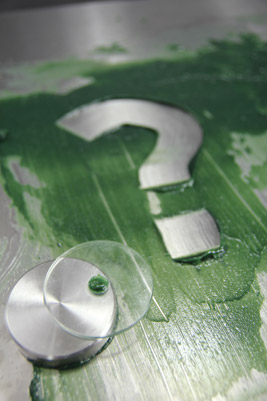Lube Tips
The “LUBE-TIPS” Section of Machinery Lubrication magazine features innovative ideas submitted by our readers. Additional tips can be found in our Lube-Tips email newsletter. If you have a tip to share, email it to admin@machinerylubricationindia. com. To receive the Lube-Tips newsletter, subscribe now at www.MachineryLubricationIndia.com/page/subscriptions.
Advice for Converting Gearboxes to Synthetics
When converting a gearbox from petroleum to synthetic oil, regardless of the synthetic base, it is advisable to thoroughly clean and then flush the gearbox with a charge of the new base material before putting the unit back in service. For some synthetics, such as with water-soluble polyalkylene glycol (PAG) oils, this is simply necessary. For others, such as polyalphaolefns (PAOs), it is just good practice.
The 10-percent Filtration Rule of Thumb
As a general guideline when periodically decontaminating a lubricant or hydraulic oil sump, the maximum pump displacement should be only 10 percent of the total volume of oil to be fltered. A 10-gallon reservoir requires no more than 1 gallon per minute for decontamination. Too much may cause a temperature increase, possible foaming and lubricant starvation. Too little pump displacement will require excessive fltration time.
Reasons for Fixing Oil Leaks
An oil leak of one drop per second amounts to approximately $1,000 of oil per year that must be replaced. If you estimate the cost of replacement, including purchasing, handling application, waste clean-up and disposal at three times the cost of the initial purchase, then each one-dropper-second leak costs your company $2,956 (based on 14,000 drops per pint and $3.50 per gallon for oil).
 Protecting New Bearings
Protecting New Bearings
Protect new bearings against contamination and condensation. New bearings should be kept in their original wrappings as long as possible and stored away from moisture where the temperature can be kept reasonably constant. It is typically not a good practice to flush the original lubricant from a new bearing, as this could introduce contamination.
Check Grease Compatibility

If you use several greases at your facility, then it is important that all of your greases are c o m p a t i b l e with one another. A safe frst assumption is that they are not compatible unless proven otherwise. To confirm compatibility, have your supplier or an independent lab run a shear stability test on the greases individually and then repeat the test using a mixture of the products that you wish to cross-check. Ideally, you would like to see little to no change in the consistency of the greases either separately or after mixing.
How to Remove Acids from Used Oil
There are several suppliers of special adsorbents that can be used to remove acids from used oil. These powder-like materials have the ability to selectively strip acids from partially oxidized oils. For instance, a used turbine oil with an acid number of 0.6 can be brought back to a level below 0.1 (near the original, new oil level) using these materials. Commonly used adsorbents include fuller’s earth and activated alumina. Ion exchange resins can also be used for this purpose. There are risks and disadvantages to reclaiming used oil in this way, including possible depletion of certain additives and the migrating of minerals from the adsorbent into the oil.
Why an Oil’s Flash Point Decreases
The only way that the flash point of an oil can decrease over time is by the addition of a contaminant with a lower flash point. In a diesel engine, this is almost certainly a fuel leak. Since diesel fuel is chemically very similar to engine oil, it cannot be removed by fltration or any other means. The long-term solution to this problem is to fnd the source of the fuel leak and correct it. Then you must change the oil, since a fuel leak will decrease the viscosity and the oil’s ability to form an adequate lube oil flm.
Causes of Nitration in Engine Oil
Nitration is the degradation of oil in the presence of nitrogen compounds. It is a common mode of gas engine lubricant degradation and is a particular problem with higher-temperature four-cycle engines. Nitrogen oxides are typically formed during fuel combustion. These nitric oxides react with water to form nitric acid. The formation of nitric acids can lead to a corrosive environment for exposed engine surfaces. Nitration also results in the formation of deposits and sludge.
